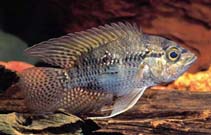| Family: |
Cichlidae (Cichlids), subfamily: Cichlasomatinae |
| Max. size: |
16 cm SL (male/unsexed); max.weight: 189.9 g |
| Environment: |
benthopelagic; freshwater; pH range: 7; dH range: 12 - 15 |
| Distribution: |
South America: Amazonas lowlands in Peru, Brazil, and Colombia, Bolivian Amazon basin, middle and lower Negro River, Branco River, also Amapá (Brazil), the Oyapock drainage in French Guiana, and the Essequibo drainage in Guyana. |
| Diagnosis: |
|
| Biology: |
Collected from a small creek, quite sunny, with amber-colored water, slow current, muddy substrate and approximately 1 m in depth. Solitary. Feeds on shrimps, insect larvae of Odonata, Coleoptera and Hemiptera, as well as on fishes like cyprinodonts, characids. Males are bigger than females. Reproduction occurs during the rainy season. Found together with Pterophyllum scalare, Heros efasciatus, Hypselecara temporalis, and Mesonauta guyanae (Ref. 35237). Maximum length 25 cm TL (Ref. 2060). |
| IUCN Red List Status: |
Least Concern (LC); Date assessed: 28 October 2020 Ref. (130435)
|
| Threat to humans: |
harmless |
Source and more info: www.fishbase.org. For personal, classroom, and other internal use only. Not for publication.

